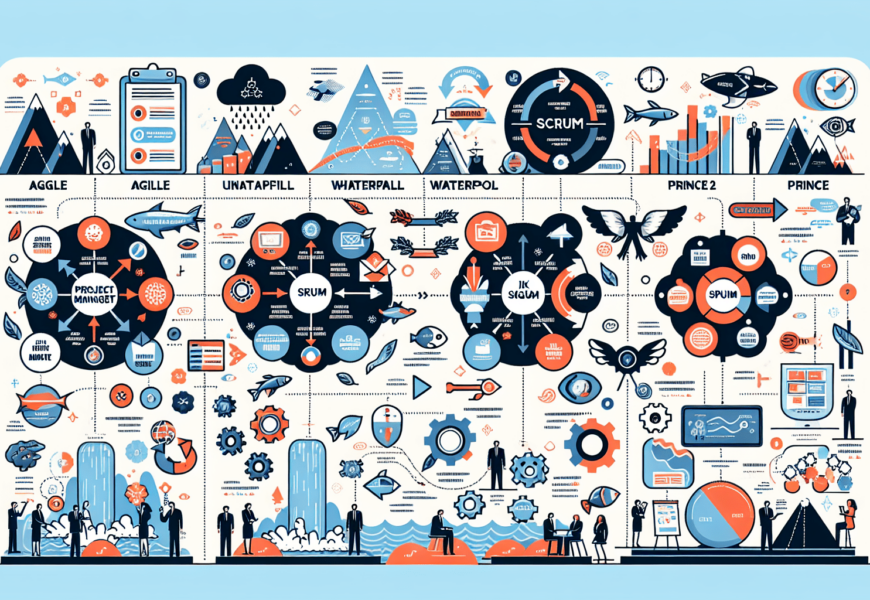Are you overwhelmed by the complexity of managing projects? In today’s fast-paced business environment, having a solid project management methodology is essential for ensuring success. This article explores the top project management methodologies and provides insights on when to use them. From the agile approach for dynamic and iterative projects to the waterfall method for more predictable and sequential tasks, understanding these methodologies will empower you to choose the right one for your project’s unique needs. So, get ready to discover the world of project management methodologies and take your projects to new heights.
Understanding Project Management Methodologies
Project management methodologies refer to the structured approaches and frameworks that organizations use to plan, execute, and deliver projects successfully. These methodologies provide a set of tools, techniques, and best practices that guide project managers and their teams throughout the project lifecycle. By following a project management methodology, you can ensure that projects are completed on time, within budget, and meet the desired scope and quality.
Importance of Project Management Methodologies
Implementing project management methodologies brings several benefits to both individuals and organizations. Firstly, these methodologies provide a standardized approach to project management, enabling teams to work together efficiently and effectively. By following a predefined methodology, everyone involved in the project understands the project phases, deliverables, and expected outcomes.
Secondly, project management methodologies improve project visibility and control. By defining the project’s scope, timeline, resources, and risks upfront, project managers can track progress and make informed decisions throughout the project. This helps in avoiding potential issues and delays and ensures that the project stays on track.
Furthermore, project management methodologies foster collaboration and communication among team members. They establish clear roles and responsibilities, define project milestones, and promote regular status updates and feedback. By creating a collaborative environment, the likelihood of misunderstandings decreases, leading to improved project outcomes.
How to Choose the Right Project Management Methodology
Selecting the most suitable project management methodology depends on various factors such as the project’s size, complexity, team structure, and the organization’s culture. Here are some key considerations to help you choose the right methodology for your project:
Project Requirements: Analyze the specific requirements of your project. Consider factors like project duration, the degree of uncertainty or change, and the level of stakeholder involvement. Projects with well-defined requirements and minimal changes may benefit from traditional methodologies, while highly dynamic projects might require a more flexible approach.
Team Agility: Assess your team’s agility and adaptability. Some methodologies require strict adherence to predefined processes and may not be suitable for teams that thrive in an agile and innovative environment. Consider the team’s preferences and capabilities when selecting a methodology.
Organizational Culture: Take into account your organization’s culture and norms. Some methodologies, such as Six Sigma or PRINCE2, focus on process-driven approaches, while others like Agile or Scrum emphasize flexibility and collaboration. Aligning the methodology with the organization’s culture increases the likelihood of successful adoption and implementation.
Experience and Expertise: Evaluate your team’s experience and expertise in utilizing different methodologies. If your team has expertise in a particular methodology or if the organization has successfully implemented a specific methodology in the past, it may be advantageous to select that methodology, as it reduces the learning curve and potential risks.
Project Complexity: Consider the complexity and nature of the project. Projects with clear and well-defined requirements may benefit from sequential approaches like Waterfall, while projects with rapidly changing requirements or high uncertainty may require an adaptive methodology like Agile or Scrum.
Resource Availability: Assess the availability and allocation of resources for the project. Some methodologies require dedicated and specialized resources, making them more suitable for projects with ample human resources. On the other hand, methodologies that promote collaboration and flexibility may be more appropriate when resources are limited.
By considering these factors, you can make an informed decision while selecting the right project management methodology for your project, ensuring a higher likelihood of success and delivering value to stakeholders.
Waterfall Project Management Methodology
Overview of Waterfall Methodology
The Waterfall methodology is a traditional, sequential project management approach. It follows a linear process in which each phase is completed before moving on to the next one. The project flows downward in a cascading manner, hence the name “Waterfall.”
The typical phases of the Waterfall methodology include requirements gathering, design, implementation, testing, deployment, and maintenance. Each phase has specific deliverables and milestones that must be completed before progressing to the next phase. This approach emphasizes thorough planning, documentation, and sequential execution.
Strengths and Weaknesses of Waterfall
One of the key strengths of the Waterfall methodology is its clear structure and defined milestones. With upfront planning and documentation, project managers and stakeholders have a clear understanding of the project’s scope, timeline, and deliverables. This helps in reducing ambiguity and managing expectations.
Additionally, the Waterfall methodology is well-suited for projects with stable and well-defined requirements. Since each phase is completed before moving on to the next, changes and rework are minimized, which can lead to better control over project costs and timelines. It is particularly useful for projects with strict regulatory or compliance requirements.
However, the Waterfall methodology has its limitations. Its linear approach makes it difficult to accommodate changes or unexpected issues that may arise during the project’s execution. Once a phase is completed, it is challenging to revisit and make modifications without impacting the subsequent phases, possibly leading to delays or compromises in project outcomes.
Moreover, the heavy emphasis on documentation in Waterfall can lead to longer project cycles and increased administrative overhead. This can be a disadvantage when working on projects with rapidly changing requirements or in dynamic environments where agility and responsiveness are paramount.
Types of Projects Suitable for Waterfall
The Waterfall methodology is best suited for projects with well-defined requirements, minimal changes, and a focus on predictability and control. It is commonly used in industries such as manufacturing, construction, and engineering where the project requirements are static and sequential execution is crucial.
Projects that have strict compliance or regulatory requirements are also well-suited for Waterfall, as it offers a highly structured and auditable approach. Additionally, projects with fixed budgets and deadlines, where change requests are limited, can benefit from the Waterfall methodology.
In summary, the Waterfall methodology is suitable for projects with stable requirements, a need for predictability, and where changes are unlikely or tightly controlled.



